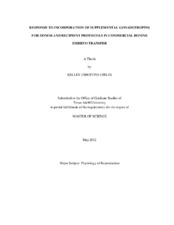| dc.description.abstract | Superovulation of donor cows, embryo transfer, and estrus synchronization of recipients are widely used technologies in the purebred cattle industry. Progress continues to be made to achieve efficient and economic use of these technologies.
The first retrospective study was conducted to compare embryo production between a stimulation protocol using only Folltropin as the gonadotropin, and a stimulation protocol using Folltropin and Pluset. Beefmaster donor cows (n=12) were stimulated using both protocols over two stimulated cycles, one protocol each cycle. Both protocols used the same synchronization protocol with only the gonadatropin injections differing. The control protocol (Folltropin protocol) consisted of seven Folltropin injections over the course of 3.5 days. The treatment protocol (Folltropin + Pluset protocol) consisted of four Folltropin injections followed by three Pluset injections over the course of 3.5 days. The mean numbers of viable embryos did not differ between treatments (P>0.01) and were 9.33 and 6.58 for the control and treatment protocols, respectively. The proportion of viable embryos to total ova for each protocol was 0.49 and 0.48 for the control and treatment protocols, respectively (P > 0.10). No significant difference on embryo production was observed between the control and treatment protocols.
The second retrospective study was performed to compare pregnancy rates after embryo transfer between Beefmaster recipients who received eCG during synchronization and recipients who did not receive eCG during synchronization. Due to the conditions of this study, statistical analysis could not be performed. Pregnancy rates are reported, but they are not statistically significant. Recipients in the control group (n=332) were synchronized with a protocol using a CIDR insert for seven days, a progesterone estradiol injection at the time of CIDR insertion, a prostaglandin (PG) injection at CIDR removal, and an estradiol injection the day after CIDR removal. Recipients in the treatment group (n=142) were synchronized using the same synchronization protocol as the control group, except eCG was administered five days after CIDR insertion. Pregnancy rates were 44.88 and 38.73 for the control and treatment groups, respectively. The addition of eCG to the synchronization protocol did not appear to be either beneficial or detrimental to pregnancy rate under the conditions of this study.
In summary, the addition of Pluset to the stimulation protocol for donors was not detrimental to embryo production. The estrus synchronization protocol with eCG for recipients did not appear to be beneficial; however, a controlled studies are still warranted to further investigate the potential effects of recipient age, parity, body condition score, or breed effect on response to eCG. | en |


